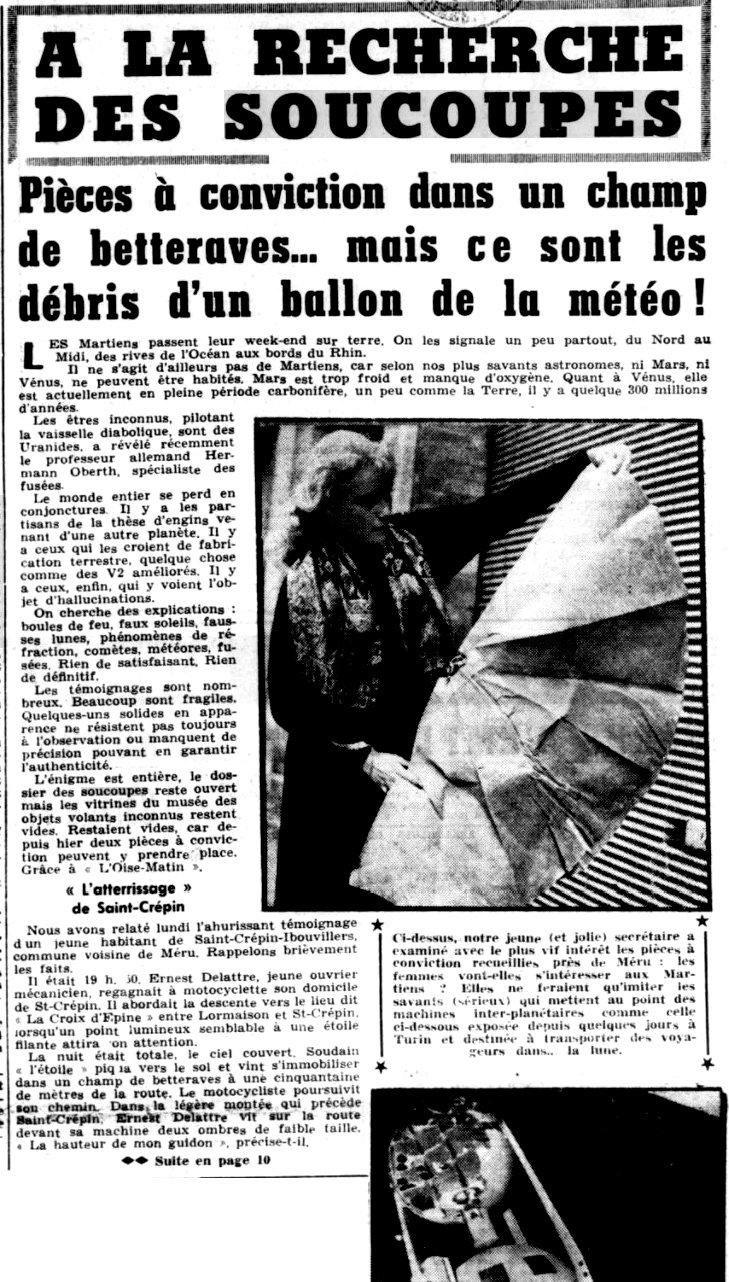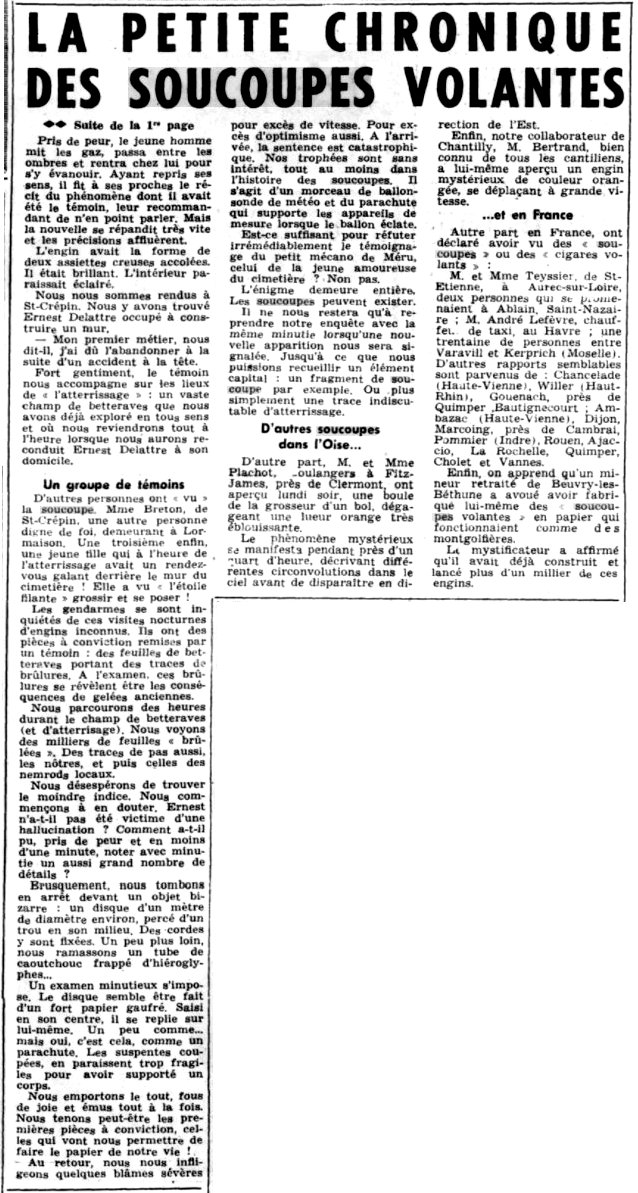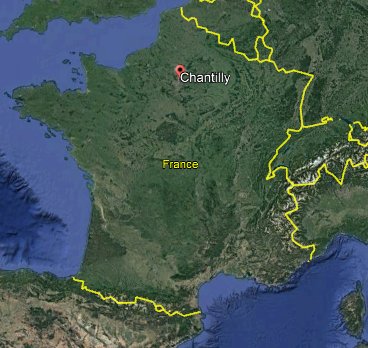
The index page for the 1954 French flap section of this website is here.
Reference for this case: Beg-Oct-54-Chantilly.
Please cite this reference in any correspondence with me regarding this case.
An article in the regional newspaper L'Oise-Matin for October 6, 1954, indicated, among other observations, that their collaborator from Chantilly, Mr. Bertrand, well known to all the residents, had seen "a mysterious craft of orange color, moving at high speed."
[Ref. lon1:] NEWSPAPER "L'OISE-MATIN":

|
Martians spend their weekend on earth. They are reported everywhere, from North to South, from the shores of the Ocean to the banks of the Rhine.
It is not about Martians, because according to our most learned astronomers neither Mars nor Venus can be inhabited. Mars is too cold and lacks oxygen. As for Venus, it is currently in the middle of the Carboniferous period, a bit like the Earth, some 300 million years ago.
The unknown beings, piloting the evil dishes, are Uranians, German professor Hermann Oberth, rocket specialist, recently revealed.
The whole world is lost in guesswork. There are the proponents of the thesis of craft coming from another planet. There are those who believe them to be earth-made, something like upgraded V2s. Finally, there are those who see it as the object of hallucinations.
We are looking for explanations: fireballs, false suns, false moons, refraction phenomena, comets, meteors, rockets. Nothing satisfactory. Nothing definitive.
The testimonies are numerous. Many are fragile. Some seemingly solid do not always stand up to observation or lack the precision that can guarantee their authenticity.
The enigma is complete, the file of the saucers remains open but the windows of the museum of unknown flying objects remain empty. Remained empty, because since yesterday two exhibits can take place there. Thanks to "L'Oise-Matin".
We reported on Monday the astounding testimony of a young resident of Saint-Crépin-Ibouvillers, a neighboring town of Méru. Let us briefly recall the facts.
It was 7 p.m. 30. Ernest Delattre, a young mechanic worker, was riding his motorcycle back to his home in Saint-Crépin. He was approaching the descent to the place called "La Croix d'Epine" between Lormaison and St-Crépin, when a dot of light similar to a shooting star caught his attention.
The night was pitch black, the sky overcast. Suddenly the "star" dived towards the ground and came to rest in a beet field about fifty meters from the road. The motorcyclist continued on his way. In the slight climb that precedes St-Crépin, Ernest Delattre saw two small shadows on the road in front of his machine. "The height of my handlebars," he says.
Continued on page 10
[Photo caption:] Above, our young (and pretty) secretary examined with keen interest the exhibits collected near Méru: will women be interested in Martians? It would only imitate the (serious) scientists who develop inter-planetary machines like the one below exhibited for a few days in Turin and intended to transport travelers to... the moon.

|
Continued from 1st page
Frightened, the young man put on the gas, went through the shadows and returned home to faint. Having regained his senses, he recounted the phenomena he had witnessed quite closely, recommending people not to spread it. But the news spread very quickly and the details poured in.
The craft was shaped like two hollow plates placed side by side. It was brilliant. The interior appeared to be lighted.
We went to St-Crépin. We found Ernest Delattre there, building a wall.
- My first job, he tells us, I had to give it up following a head accident.
Very kindly, the witness accompanies us to the "landing" site: a vast beet field that we had already explored in all directions and where we would go back after returning Ernest Delattre to his home.
Other people "saw" the saucer. Mme Breton, from St-Crépin, another trustworthy person, residing in Lormaison. Finally a third, a young girl who at the time of the landing had a romantic date behind the wall of the cemetery! She saw the shooting star grow bigger and land!
The gendarmes were worried about these nocturnal visits of unknown craft. They have exhibits given by a witness: beet leaves with traces of burns. On examination, these burns turn out to be the consequences of old frosts.
We walk for hours through the beet (and landing) field. We see thousands of burnt leaves. Footprints too, ours, and then those of local nimrods.
We are desperate to find any clue. We are beginning to doubt it. Wasn't Ernest the victim of a hallucination? How could he, seized with fear and in less than a minute, carefully note so many details?
Suddenly, we come to a stop in front of a strange object: a disc about a meter in diameter, pierced with a hole in the middle. Ropes are attached to it. A little further on, we pick up a rubber tube stamped with hieroglyphics...
Careful consideration is in order. The disc appears to be made of heavy embossed paper. Seized in its center, it folds in on itself. Kind of like... but yes, that's it, like a parachute. The lines cut, seem too fragile to have supported a body.
We take it all away, overjoyed and moved at the same time. We may have the first pieces of evidence, those that will allow us to make the paper of our life!
On the way back we inflicted some severe blame on ourselves for speeding. For excess of optimism too. On arrival, the sentence is catastrophic. Our trophies are irrelevant, at least in the history of saucers. This is a piece of weather balloon and parachute that supports the measuring devices when the balloon bursts.
Is this enough to irremediably refute the testimony of Méru's little mechanic, that of the young lover of the cemetery? No.
The riddle remains intact.
Saucers can exist.
All we have to do is resume our investigation with the same thoroughness when a new appearance is reported to us. Until we can collect a crucial element: a fragment of a saucer for example. Or more simply an indisputable trace of landing.
Also, Mr. and Mrs. Plachot, bakers in Fitz-James, near Clermont, saw a ball the size of a bowl on Monday evening, giving off a very dazzling orange glow.
The mysterious phenomenon manifested itself for nearly a quarter of an hour, performing various convolutions in the sky before disappearing in an easterly direction.
Finally, our collaborator from Chantilly, Mr. Bertrand, well known to all Cantillians, himself saw a mysterious orange colored machine, moving at high speed.
Elsewhere in France, said they had seen "saucers" or "flying cigars":
Mr. and Mme Tessier, from St-Etienne, in Aurec-sur-Loire, two people who were walking at Ablain Saint-Nazaire; Mr. André Lefèvre, taxi driver in Le Havre; about thirty people between Varavill [sic] and Kerprich (Moselle).
Other similar reports came from: Chancelade (Haute-Vienne), Willer (Haut-Rhin), Gouesnach, near Quimper, Bautignecourt; Ambazac (Haute-Vienne), Dijon, Marcoing, near Cambrai, Pommier (Indre), Rouen, Ajaccio, La Rochelle, Quimper, Cholet and Valves.
Finally, we learn that a retired miner of Beuvry-les-Béthune confessed to having made himself some flying saucers in paper which worked like hot air balloons.
The hoaxer claimed that he had already built and launched more than a thousand of these devices.

|
Unidentified, but insufficient information.
(These keywords are only to help queries and are not implying anything.)
Chantilly, Oise, Bertrand, journalist, craft, orange, moving, fast
[----] indicates sources that are not yet available to me.
| Version: | Created/Changed by: | Date: | Change Description: |
|---|---|---|---|
| 1.0 | Patrick Gross | May 6, 2021 | First published, [lon1]. |